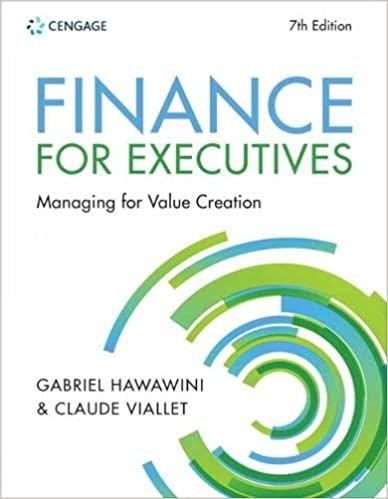1. Which of the following is not a basic component of the investment process?
a) investor characteristics
b) investment vehicles
c) strategy development
d) strategy monitoring
e) All of the above are basic components of the investment process.
2. Which type of risk is faced by holders of corporate bonds that can be considered non-existent by holders of government bonds?
a) foreign exchange rate risk
b) inflation rate risk
c) market risk
d) default risk
3. You purchase shares with a market price of $60 when the initial margin requirement is 80%. The maintenance margin is 30%. What is the highest price that will trigger a margin call?
a) $8
b) $12
c) $17
d) $24
e) $48
4. Which type of underwriting arrangement requires the underwriter to buy the entire new issue from the issuing corporation at a predetermined price, and absorb all unsold shares for his own account at this price?
a) firm commitment
b) best effort
c) standby commitment
d) contractual offering
e) rights issue
5. Which type of fund is most likely to invest in high-grade commercial paper?
a) equity fund
b) bond fund
c) balanced fund
d) money market mutual fund
e) index fund
6. A mutual fund owns securities with a market value of $9,000,000, has 500,000 shares outstanding, owes its employees $200,000, and has a 3% load charge. The net asset value per share is:
a) $18.00
b) $18.90
c) $16.85
d) $17.60
e) $18.48
7. The current market value of all securities held by a fund less any liabilities, divided by the number of shares outstanding is the:
a) book value
b) net asset value
c) market value
d) net profit
e) share price
8. When underwriters issue securities on a best effort basis, they
a) sell as much of the stock as possible, but with no guarantee.
b) submit a bid for purchase, with the issuer compares to other bids
c) buy the entire issue from the firm.
d) guarantee that the issuer will receive the spread
9. Which of the following statements about corporate governance is wrong?
a) Corporate governance is important because it is the framework through which shareholders can be assured of legal compliance.
b) Corporate governance is a method of controlling the corporation.
c) Corporate governance establishes the appropriate ethical conduct of the corporation.
d) Corporate control usually rests with the CEO, who is elected by the common shareholders.
e) With the increasing concentration of shares held by large institutional investors, the role of active corporate governance on the part of the shareholders will increase.
10. Studies have shown that, on average, new securities issues are
a) subject to floatation costs of approximately 35%
b) overpriced by the amount of the spread
c) underpriced
d) overpriced to reward venture capitalists
11. Which of the following should be used when estimating the average performance across different securities for one period of time?
a) geometric average
b) arithmetic average
c) compound average
d) complex average
12. Which of the following statements about risk is correct?
a) If all investors were risk averse, there would be no positive risk premium.
b) The variance of return is a measure of the dispersion around the mean and is used as a measure of risk.
c) Risk-neutral investors are willing to pay a higher price for an asset whose variance increases.
d) Investors are risk averse when they ignore an assets variance and only consider the assets expected return.
e) Most investors are risk neutral.
13. An analyst developed the following probability distribution of potential rates of return for Stock Z under three scenarios and later revised the expected rate of return for each scenario:
Original ExpectedRevised Expected
ScenarioProbabilityRate of ReturnRate of Return
10.200.200.210
20.500.300.310
30.300.500.525
If the original variance of the expected rate of return was 0.0124, Stock Zs revised standard deviation of expected return will be:
a) 0.1050.
b) 0.1114.
c) 0.1141.
d) 0.1169.
14. Which of the following is not a variable in the calculation of the variance of a portfolio?
a) the correlations between assets
b) the variance of each asset
c) the expected return of each asset
d) the proportion invested in each asset
e) the covariances between assets
15. Total risk decrease as the:
a) number of stocks in the portfolio decreases
b) correlation between the returns of the securities in the portfolio decreases
c) correlation between the returns of the securities in the portfolio increases
d) number of different industries in the portfolio decreases
e) number of stocks in the same industry increases






